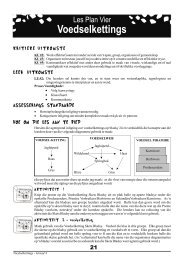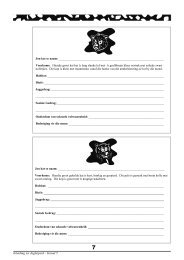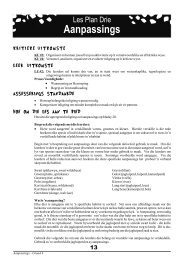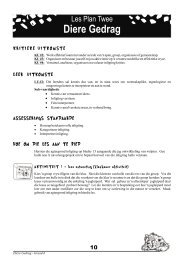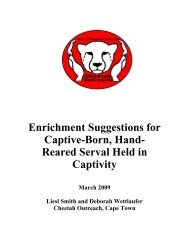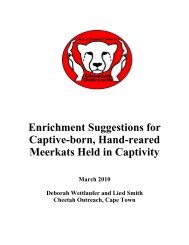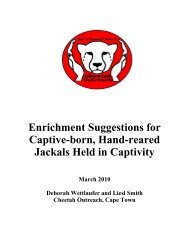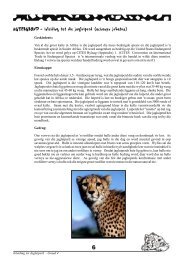Enrichment Suggestions for Captive-born, Hand-reared Caracal ...
Enrichment Suggestions for Captive-born, Hand-reared Caracal ...
Enrichment Suggestions for Captive-born, Hand-reared Caracal ...
Create successful ePaper yourself
Turn your PDF publications into a flip-book with our unique Google optimized e-Paper software.
<strong>Enrichment</strong> <strong>Suggestions</strong> <strong>for</strong><br />
<strong>Captive</strong>-<strong>born</strong>, <strong>Hand</strong>-<strong>reared</strong><br />
<strong>Caracal</strong> Held in Captivity<br />
March 2010<br />
Deborah Wettlaufer and Liesl Smith<br />
Cheetah Outreach, Cape Town
<strong>Enrichment</strong><br />
Animals in captivity have a lot of time on their hands. Whereas wild animals would fill<br />
their time with activities such as hunting, searching <strong>for</strong> water or shelter, protecting their<br />
territory or searching <strong>for</strong> a mate, captive animals very often are provided all of these.<br />
This could potentially create problems such as boredom, frustration, stereotypic behaviors<br />
and stress. Undesirable behaviours include self-injurious actions like excessive grooming;<br />
abnormal behaviours such as regurgitation and reingestion; aggressive behaviours; and<br />
stereotypic behaviours. Behaviour is an important indication of welfare and enrichment<br />
enhances welfare of animals in captivity.<br />
<strong>Enrichment</strong> becomes a valuable and necessary practice by creating activities or providing<br />
stimulation that maximizes their quality of life and leads to inquisitive behavior.<br />
By enriching the animal’s environment, you empower the animal to have control over its<br />
environment and you give the animal a choice. Ignoring something is still a choice.<br />
Apart from the fact that enrichment provides methods of passing time, the added physical<br />
and mental stimulation might also cause better reproductive success and improve visitor’s<br />
experiences since the image of healthy and well-adjusted animals are promoted.<br />
Different <strong>for</strong>ms of enrichment used <strong>for</strong> captive animals today include:<br />
Enclosure Design<br />
Feeding or <strong>for</strong>aging<br />
Visual and Auditory<br />
Olfactory<br />
Novel Objects and Toys<br />
Exercise<br />
Social Interaction/Tactile<br />
Behavioural Conditioning<br />
<strong>Enrichment</strong> should be considered part of the daily husbandry routine at all responsible<br />
animal care facilities. An efficient enrichment programme can be more important than the<br />
size of the enclosures the animals are kept in. Environmental enrichment is not a luxury but<br />
a management tool.<br />
When developing an enrichment programme at a captive facility, the habits, behaviours and<br />
nature of the species, and the personality of the specific individual need to be considered.<br />
<strong>Enrichment</strong> suggestions <strong>for</strong> the caracal include the following:<br />
Produced by Cheetah Outreach (Last Updated: November 2012)<br />
Copyright © 2010-2013 Cheetah Outreach. All rights reserved.<br />
cheetah@intekom.co.za Http://www.cheetah.co.za<br />
Homes Provided by Heartland and Eikendal<br />
2
Enclosure Design<br />
Enclosures should be designed in order to address the needs <strong>for</strong> space, shade, shelter,<br />
privacy, stimulation, elevation and where appropriate, public viewing.<br />
When designing enclosure layouts the following should be incorporated:<br />
Shade<br />
Structures providing shade are an essential element in every enclosure.<br />
Shelter<br />
Waterproof huts not only serve as sleeping quarters and as a hideaway, but also provide a<br />
lookout post to the animal. The inside is filled with straw <strong>for</strong> warmth and com<strong>for</strong>t.<br />
Produced by Cheetah Outreach (Last Updated: November 2012)<br />
Copyright © 2010-2013 Cheetah Outreach. All rights reserved.<br />
cheetah@intekom.co.za Http://www.cheetah.co.za<br />
Homes Provided by Heartland and Eikendal<br />
3
Water<br />
Water should be provided in solid, non-toxic containers. Containers should be placed in an<br />
easily accessible and shaded area. All water containers should be disinfected on a regular<br />
basis and the same container used <strong>for</strong> the same cat preferably.<br />
Logs<br />
Big logs can be packed at angles to one another. Alternatively flat pieces of logs can be<br />
stacked loosely on top of and against one another. Logs provide an often-visited area to<br />
many cats.<br />
Vegetation<br />
In the wild caracals prefer woodlands, thickets or scrub and stony outcropping. In open<br />
savannah, they will often seek out hiding places among dense riverine thickets and only<br />
venture out to open grassland at night to hunt. In captivity it’s important to provide enough<br />
vegetation and cover in the enclosure, whether in the <strong>for</strong>m of shrubs, tall grass or piles of<br />
dead branches. The caracal at Cheetah Outreach particularly likes lying in or chasing<br />
objects in patches of tall grass. She also enjoys hiding under piles of branches.<br />
Produced by Cheetah Outreach (Last Updated: November 2012)<br />
Copyright © 2010-2013 Cheetah Outreach. All rights reserved.<br />
cheetah@intekom.co.za Http://www.cheetah.co.za<br />
Homes Provided by Heartland and Eikendal<br />
4
Jumping Plat<strong>for</strong>m<br />
Plat<strong>for</strong>ms encourage jumping behaviour and provide an elevated place <strong>for</strong> caracals to view<br />
their surroundings or get off the ground when wet or muddy.<br />
When planning to build a plat<strong>for</strong>m the following should be considered:<br />
1) Non-toxic, safe materials should be used.<br />
2) The plat<strong>for</strong>m should be placed in such a position as not to allow any jumping or<br />
climbing over fences or other structures. The plat<strong>for</strong>ms are all erected on a flat,<br />
open section of grass, well away from any fences, huts or any other structure.<br />
3) There should be no protruding or sharp objects. There should be no objects that<br />
could cut, injure or get the animal entangled.<br />
Privacy<br />
Concealed, private areas should be provided in all caracal enclosures. Logs, areas of shade<br />
cloth, palm fronds and other tree branches, reeds or simple bamboo walls can be used to<br />
Produced by Cheetah Outreach (Last Updated: November 2012)<br />
Copyright © 2010-2013 Cheetah Outreach. All rights reserved.<br />
cheetah@intekom.co.za Http://www.cheetah.co.za<br />
Homes Provided by Heartland and Eikendal<br />
5
provide these. <strong>Caracal</strong>s in the wild often spend the hot hours of the day hiding in burrows,<br />
hollow trees, dense thickets or rocky outcrops, and in captivity, enjoy small enclosed<br />
spaces, such as small crates or portable dog houses.<br />
Security<br />
<strong>Caracal</strong> enclosures should be roofed to prevent escape.<br />
Vertical Space<br />
The enclosure should offer vertical space to accommodate jumping and climbing<br />
behaviour.<br />
Produced by Cheetah Outreach (Last Updated: November 2012)<br />
Copyright © 2010-2013 Cheetah Outreach. All rights reserved.<br />
cheetah@intekom.co.za Http://www.cheetah.co.za<br />
Homes Provided by Heartland and Eikendal<br />
6
Manipulating Enclosure Layout<br />
Gates separating adjacent enclosures might be opened to provide more space and<br />
opportunities <strong>for</strong> enrichment.<br />
Habitat Modifications<br />
Habitat modification by moving and changing exhibits inside the enclosures might provide<br />
stimulation.<br />
Feeding<br />
Elevating Food<br />
<strong>Caracal</strong>s are agile climbers and have remarkable jumping powers. Fast bounds can take a<br />
caracal several metres up into a tree or over rocks after dassies and other prey. Placing<br />
meat on a sloping tree limb or plat<strong>for</strong>m encourages the caracal to climb or jump <strong>for</strong> her<br />
food.<br />
Produced by Cheetah Outreach (Last Updated: November 2012)<br />
Copyright © 2010-2013 Cheetah Outreach. All rights reserved.<br />
cheetah@intekom.co.za Http://www.cheetah.co.za<br />
Homes Provided by Heartland and Eikendal<br />
7
Hanging Food from Top of Enclosure<br />
<strong>Caracal</strong>s use their jumping ability to catch birds in the air, leaping high and batting<br />
sideways with their paws or using both paws together to snag the bird from the air.<br />
Hanging food from top of enclosure encourages this natural bird hunting behaviour.<br />
Hanging food at top of a post encourages climbing and grabbing <strong>for</strong> food.<br />
Bungee Feeder<br />
Hanging a large bone or large bloodsicle with meat from a bungee cord prolongs feeding by<br />
encouraging the caracal to grab, hold, pull, rip and try to drag away the attached food. The<br />
caracal at Cheetah Outreach loves bloodsicles and a large bloodsicle attached to the bungee<br />
feeder will keep her occupied <strong>for</strong> 30 minutes or more. She has figured out how to hold it so<br />
she can lick it without it moving but when the meat is exposed, she tries to rip it off, like<br />
meat on a carcass, and to carry it off. A bone attached to the bungee feeder causes much<br />
excitement and will stimulate the caracal to jump, leap and stand on hind legs to get at the<br />
bone.<br />
It is essential that a piece of PVC pipe or hosepipe go over the bungee <strong>for</strong> safety, to prevent<br />
it from tangling around the caracal’s neck or bouncing back at her face.<br />
Produced by Cheetah Outreach (Last Updated: November 2012)<br />
Copyright © 2010-2013 Cheetah Outreach. All rights reserved.<br />
cheetah@intekom.co.za Http://www.cheetah.co.za<br />
Homes Provided by Heartland and Eikendal<br />
8
Feeding in Cardboard Boxes or Toilet Paper Rolls<br />
Placing pieces of meat inside a cardboard box or toilet paper roll encourages the caracal to<br />
search <strong>for</strong> food and prolongs the length of feeding activity.<br />
Whole or Partial Birds with Feathers<br />
In the wild caracals take birds on a regular basis, from doves to kori bustards and eagles.<br />
Feeding with feathers encourages natural stalking and jumping behaviour as well as<br />
plucking be<strong>for</strong>e eating. Feeding should be supervised and remnants from the carcass<br />
removed. The origin and health status of the animal offered should be known.<br />
Produced by Cheetah Outreach (Last Updated: November 2012)<br />
Copyright © 2010-2013 Cheetah Outreach. All rights reserved.<br />
cheetah@intekom.co.za Http://www.cheetah.co.za<br />
Homes Provided by Heartland and Eikendal<br />
9
Day-old Chicks<br />
Dead baby chicks can supplement normal diet and add enrichment by throwing or hanging<br />
<strong>for</strong> a caracal. Chicks should be de-yolked prior to feeding.<br />
Whole or Partial Large Carcass Feeding<br />
Whole or partial carcasses can provide hours of stimulation and encourage natural hunting<br />
and feeding behaviour, including pouncing, attacking with claws, biting, dragging ‘prey’<br />
into cover, and plucking and licking fur. The origin and health status of the animal offered<br />
should be known and the session supervised.<br />
Whole Squirrels, Rats and Mice<br />
When available, whole carcasses of natural prey such as squirrels, rats and mice can be<br />
given (guts should be removed). Apart from providing roughage, whole carcasses provide<br />
much stimulation, encouraging natural hunting and eating behaviour, such as pouncing,<br />
tossing prey, licking and plucking fur. Whole carcasses also increase the length of feeding<br />
activity.<br />
Produced by Cheetah Outreach (Last Updated: November 2012)<br />
Copyright © 2010-2013 Cheetah Outreach. All rights reserved.<br />
cheetah@intekom.co.za Http://www.cheetah.co.za<br />
Homes Provided by Heartland and Eikendal<br />
10
Meat with Fur<br />
Sections of horsemeat and rabbit with fur can be given. Apart from providing roughage,<br />
meat with fur also changes the texture of the food and increases the length of feeding<br />
activity.<br />
Horse, Turkey or Other Large Bones<br />
Bones prolong feeding and keep the caracal occupied <strong>for</strong> up to an hour or more. Bones<br />
should always have a fair amount of meat on them or alternatively only be given after a<br />
meal.<br />
Bloodsicles<br />
These are made by freezing blood and a few pieces of meat in small plastic containers and<br />
can be offered on warm days.<br />
Produced by Cheetah Outreach (Last Updated: November 2012)<br />
Copyright © 2010-2013 Cheetah Outreach. All rights reserved.<br />
cheetah@intekom.co.za Http://www.cheetah.co.za<br />
Homes Provided by Heartland and Eikendal<br />
11
Raw Eggs<br />
Raw eggs are a great treat <strong>for</strong> a caracal. Giving the egg intact encourages the caracal to use<br />
her cognitive skills to open it up. The caracal at Cheetah Outreach usually licks the egg <strong>for</strong><br />
a while, then picks it up and bites it open. When the egg is gone, she continues to lick the<br />
inside of the shell, sometimes eating some of the shell too.<br />
Visual and Auditory<br />
Objects that provide visual and auditory stimulation include the following:<br />
Outside Stimuli<br />
Outside stimuli includes passing trains, motorbikes, running children, other animals,<br />
laborers, bicycles and wheelchairs. Having visual access to some of these not only<br />
provides mental stimulation, but can also provide good exercise since some animals will<br />
chase some of these objects and show much interest.<br />
Produced by Cheetah Outreach (Last Updated: November 2012)<br />
Copyright © 2010-2013 Cheetah Outreach. All rights reserved.<br />
cheetah@intekom.co.za Http://www.cheetah.co.za<br />
Homes Provided by Heartland and Eikendal<br />
12
Other Animals<br />
Walking different types of animals on their leads past the caracal enclosure or walking the<br />
caracal past their enclosures provides much interest and stimulation. The caracal normally<br />
follows the animal along the fence, and depending on the animal, tries to sniff it (servals<br />
she is familiar with), stalk and chase it (prey animals like bat-eared foxes or meerkats) or<br />
hisses and spits at it (predators like cheetahs, jackals or Anatolian dogs). Be careful not to<br />
allow the animal, especially bat-eared foxes or meerkats, too close to the fence, since the<br />
caracal may try to grab the animal through the fence.<br />
Adjacent enclosures containing serval and jackals also provide much stimulation <strong>for</strong> the<br />
caracal at Cheetah Outreach. She sometimes charges the fence, and hisses and spits at the<br />
jackals or sits and watches the serval.<br />
Olfactory<br />
Moving Animals Between Enclosures<br />
The caracal can be moved into a <strong>for</strong>eign or lesser-known enclosure. It is important that the<br />
enclosure has a fenced roof to prevent escape. If this is not possible the animal should be<br />
walked on a harness and lead. Intense sniffing and investigating may be observed.<br />
Moving Objects between Enclosures.<br />
Some of the exhibits can be moved from one enclosure to another, such as a portable dog<br />
house, splash pool or piles of branches. The health status of all animals should always be<br />
known. Objects should never be moved from a sick or compromised animal to the<br />
enclosure of a healthy animal.<br />
Novel Objects and Toys<br />
Toys encourage caracals to play and release pent-up energy. Some toys will encourage<br />
natural behaviours such as stalking, pouncing, throwing object and batting it in the air,<br />
plucking and biting, jumping and leaping in the air. When there is no supervision, toys<br />
should be taken away and be put out of reach, to avoid being ingested.<br />
Favourite toys <strong>for</strong> caracals include soft toys, rubber Kong toys, rope toys and balls. They<br />
also respond well to any toy that has feathers attached. When choosing objects <strong>for</strong> animals<br />
to play with, care should be taken that these objects are non-toxic and preferably organic in<br />
nature.<br />
Never leave any toys unsupervised with an animal.<br />
Soft and Rubber Toys<br />
Playing with soft toys brings out many natural hunting behaviours in caracals: raking prey<br />
with hind legs, enfolding prey with both <strong>for</strong>e and hind legs, clamping jaws on prey’s neck<br />
Produced by Cheetah Outreach (Last Updated: November 2012)<br />
Copyright © 2010-2013 Cheetah Outreach. All rights reserved.<br />
cheetah@intekom.co.za Http://www.cheetah.co.za<br />
Homes Provided by Heartland and Eikendal<br />
13
or throat, worrying prey by shaking, kicking and pulling on it, and plucking prey be<strong>for</strong>e<br />
eating. The caracal at Cheetah Outreach prefers soft toys to all other novel objects, except<br />
bird feathers, and has been observed engaging in all of these hunting behaviours when<br />
given a soft toy to play with.<br />
Inside stuffing as well as solid objects such as button eyes should be removed be<strong>for</strong>e<br />
allowing the animal to play with a toy. Care should be taken that the caracal doesn’t open<br />
up soft toys through plucking or biting.<br />
Balls<br />
<strong>Caracal</strong>s respond well to balls. It can either be thrown with a rolling motion <strong>for</strong> the caracal<br />
to chase or placed in an empty plastic splash pool from which she can try and retrieve it.<br />
Mop and Rope Toys<br />
The caracal at Cheetah Outreach enjoys stalking, chasing, attacking and biting a mop or<br />
rope toy, which brings out her hunting instincts. Care should be taken that the caracal<br />
doesn’t rip off pieces of mop or rope toys and swallow them.<br />
Produced by Cheetah Outreach (Last Updated: November 2012)<br />
Copyright © 2010-2013 Cheetah Outreach. All rights reserved.<br />
cheetah@intekom.co.za Http://www.cheetah.co.za<br />
Homes Provided by Heartland and Eikendal<br />
14
Blanket<br />
The caracal at Cheetah Outreach enjoys playing with a blanket. She stalks it, pounces or<br />
leaps <strong>for</strong> it, kicks and bites, and plays tug-of-war with it and a handler. She only plays with<br />
a blanket under observation of a handler to ensure that she doesn’t chew pieces off or<br />
swallow them.<br />
Plastic Bottles<br />
These can be offered loose or attached to a whip to chase after.<br />
Feathers<br />
<strong>Caracal</strong>s react strongly to feathers since birds are a favourite prey in the wild. Guinea fowl<br />
and other wings can be attached to a whip to encourage chasing and jumping or thrown to<br />
Produced by Cheetah Outreach (Last Updated: November 2012)<br />
Copyright © 2010-2013 Cheetah Outreach. All rights reserved.<br />
cheetah@intekom.co.za Http://www.cheetah.co.za<br />
Homes Provided by Heartland and Eikendal<br />
15
e played with. It is imperative to make sure these are disease- and parasite-free. This can<br />
be done by freezing, washing, microwaving or leaving the objects in the sun.<br />
Plastic Splash Pool<br />
Empty pools can be covered with vegetation to encourage the caracal to hide inside. Toys<br />
can be placed inside <strong>for</strong> the caracal to play with.<br />
Cardboard Boxes<br />
Cardboard boxes are often stalked, kicked and bitten. The caracal at Cheetah Outreach also<br />
enjoys getting inside larger boxes as she enjoys small spaces. Any harmful substances such<br />
as staples or plastic tape should be removed first and caracals should be carefully<br />
supervised while playing to make sure they do not eat and ingest part of the cardboard.<br />
Produced by Cheetah Outreach (Last Updated: November 2012)<br />
Copyright © 2010-2013 Cheetah Outreach. All rights reserved.<br />
cheetah@intekom.co.za Http://www.cheetah.co.za<br />
Homes Provided by Heartland and Eikendal<br />
16
Exercise<br />
Exercise is essential and is a part of husbandry that cannot be compromised on. Not only<br />
does the activity help to maintain a healthy physical condition, but it also provides excellent<br />
mental stimulation. Exercise can be provided by the following means:<br />
Toys<br />
Soft toys are some of the caracal’s favourite toys. Stuffed toys can be thrown <strong>for</strong> the<br />
caracal to retrieve and play with. Playing with soft toys results in much exercise through<br />
chasing, jumping, pouncing, kicking and throwing of toys.<br />
Never leave any toys in the animal’s enclosure without supervision.<br />
Whip with Novelty Item<br />
A plastic bottle, soft toy or bird wing can be attached to a whip and used to encourage<br />
chasing and jumping behavior.<br />
Produced by Cheetah Outreach (Last Updated: November 2012)<br />
Copyright © 2010-2013 Cheetah Outreach. All rights reserved.<br />
cheetah@intekom.co.za Http://www.cheetah.co.za<br />
Homes Provided by Heartland and Eikendal<br />
17
Hanging Novelty Items<br />
Powerful hindquarters can launch a caracal 3 metres into the air from a sitting position.<br />
Objects such as soft toys or bird wings can be attached to the top of the enclosure or the top<br />
of a post to encourage jumping and climbing.<br />
Walks<br />
Walks can provide the handler with many opportunities to enrich a caracal’s life. New and<br />
different environments can provide a variety of smells and sights to investigate. The<br />
caracal at Cheetah Outreach enjoys exploring different areas of the facility on walks,<br />
watching birds out on the adjacent vlei, and interacting with other small carnivores through<br />
the fence.<br />
Produced by Cheetah Outreach (Last Updated: November 2012)<br />
Copyright © 2010-2013 Cheetah Outreach. All rights reserved.<br />
cheetah@intekom.co.za Http://www.cheetah.co.za<br />
Homes Provided by Heartland and Eikendal<br />
18
Social interaction/Tactile<br />
Interaction with Staff/Volunteers<br />
For animals kept in captivity and thus exposed to people, it is to their benefit to view<br />
humans positively. This greatly minimizes one of the main stresses in captivity.<br />
Interaction with Other Animals<br />
Seeing, smelling and interacting with other animals through a fence or at a distance can<br />
greatly enrich a captive caracal’s life. This should be a positive experience <strong>for</strong> the animals<br />
and not lead to anxiety. Care should be taken to assess the demeanor and behaviour of all<br />
animals carefully.<br />
Produced by Cheetah Outreach (Last Updated: November 2012)<br />
Copyright © 2010-2013 Cheetah Outreach. All rights reserved.<br />
cheetah@intekom.co.za Http://www.cheetah.co.za<br />
Homes Provided by Heartland and Eikendal<br />
19
Interaction with the Public<br />
Individuals that work with the public should be selected carefully and must only include<br />
animals that are temperamentally suited to having interaction with the public.<br />
The caracal at Cheetah Outreach loves human attention and often seeks out strangers to rub<br />
against. Visits with the public include allowing a few people into her enclosure to visit her<br />
or touch encounters with small groups of visitors while on a walk. Only one person at a<br />
time should be allowed to approach the caracal and a handler must always be present.<br />
Behavioral Conditioning<br />
Behavioral conditioning is very important since it provides mental stimulation and<br />
challenges cognitive skills. The level of conditioning depends on the individual and might<br />
be one or all of the following:<br />
Produced by Cheetah Outreach (Last Updated: November 2012)<br />
Copyright © 2010-2013 Cheetah Outreach. All rights reserved.<br />
cheetah@intekom.co.za Http://www.cheetah.co.za<br />
Homes Provided by Heartland and Eikendal<br />
20
Lead Walking<br />
Lead walking begins at an early age in order <strong>for</strong> young cats to get accustomed to the<br />
restricted feeling of harness and lead. Lead walking is important <strong>for</strong> all ambassador cats.<br />
Station Training<br />
Station training entails the use of verbal commands and hand signals to teach an animal to<br />
jump on an object and remain there until released with a reward. Station training can be<br />
used to facilitate feeding, slow down eating, control an animal while people are doing<br />
husbandry duties in an enclosure as well as provide mental stimulation. The caracal at<br />
Cheetah Outreach learns quickly and enjoys these sessions.<br />
Produced by Cheetah Outreach (Last Updated: November 2012)<br />
Copyright © 2010-2013 Cheetah Outreach. All rights reserved.<br />
cheetah@intekom.co.za Http://www.cheetah.co.za<br />
Homes Provided by Heartland and Eikendal<br />
21
Clicker Conditioning<br />
This type of conditioning is used to shape behavior by means of positive rein<strong>for</strong>cement.<br />
Use of a clicker can be extremely helpful in situations where you might have to manipulate<br />
the animal’s movements, such as on a film set. It is essential that the handler display a<br />
good sense of timing when using a clicker.<br />
Transportation<br />
Crates may be used to transport animals to the vet or in the event of a fire or other<br />
emergency. Rein<strong>for</strong>cing familiarity with crates can be done by feeding inside the crate on a<br />
rotational basis. This will ensure that the animal does not harbor negative feelings toward<br />
the crate. This is very often the case since the crates are used to transport them to the vet<br />
and represent negative experiences. Crates should always be disinfected be<strong>for</strong>e being<br />
moved to a different enclosure. Crates will also be needed in the event of a fire and being<br />
able to load the animals quickly and without resistance might mean the difference between<br />
life and death. By increasing the length of time the animal stays in the crate you can train<br />
them to accept the crate as a safe place <strong>for</strong> flying etc.<br />
Produced by Cheetah Outreach (Last Updated: November 2012)<br />
Copyright © 2010-2013 Cheetah Outreach. All rights reserved.<br />
cheetah@intekom.co.za Http://www.cheetah.co.za<br />
Homes Provided by Heartland and Eikendal<br />
22



